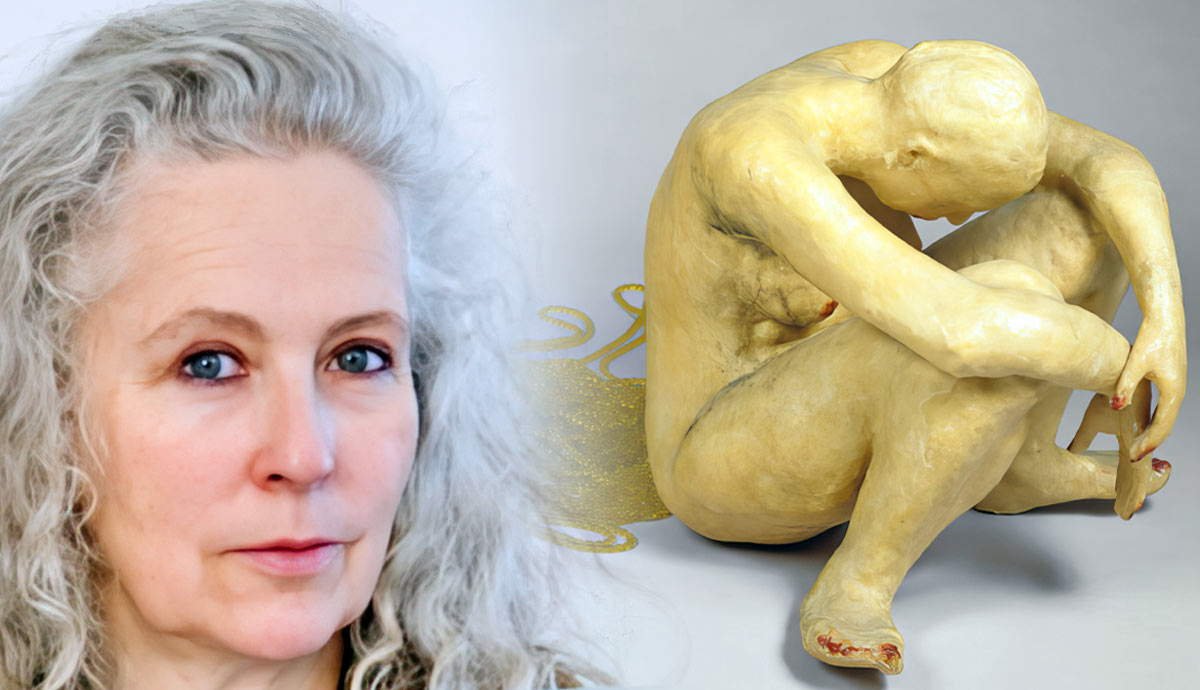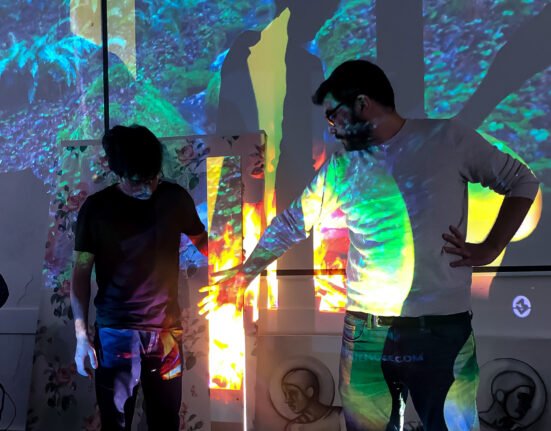
During her over four-decade-long career, contemporary American artist Kiki Smith predominantly explored themes concerning the human body, identity, and feminism. She was one of the first artists to address the AIDS crisis. Smith’s work also explores issues related to the female body and identity. She has challenged traditional depictions of women and their roles in art, by tackling issues such as sexuality, fertility, and the aging process. Smith’s art reflects a broader social and cultural dialogue about gender and social justice.
Early Life of Kiki Smith

Kiki Smith was born in West Germany on January 18, 1954 to an artistic family. The following year, Smiths moved to the U.S. State of New Jersey. Her mother Jane Lawrence was an actress and an opera singer, while her father, Tony Smith, was a renowned minimalist sculptor. Even though her figurative approach to art varied from her father’s minimalist and geometric approach, Smith repeatedly emphasized in interviews that growing up close to a sculptor influenced her development as a visual artist. She attended a Catholic school and used that experience in her art, exploring religious figures such as Mary Magdalene and the Virgin Mary.
Kiki Smith enrolled in Hartford Art School in Connecticut in 1974. After a year and a half, she left for New York where she began doing various odd jobs. For example, she worked as a short-order cook and as an electrician’s assistant. During this time, Smith joined an artistic collective titled the Colab (short for Collaborative Projects Inc.) where artists from diverse backgrounds created works and discussed topics of a political nature.
Kiki Smith had her first solo exhibition Life Wants to Live in 1982 at The Kitchen, one of New York City’s oldest nonprofit alternative art centers. Since then, her artwork has been shown in almost 150 solo exhibitions across museums and galleries globally. Today, Kiki Smith works as a teacher at Columbia and New York University.
Get the latest articles delivered to your inbox
Sign up to our Free Weekly Newsletter
Throughout her career, Smith has exercised heterogeneous approaches to art, both theme-wise and medium-wise. In a multidisciplinary manner, she expressed herself in printmaking, sculpture, tapestry, mosaic, photography, and drawing. Smith also used various traditional and nontraditional materials in her art such as glass, bronze, paper, glitter, steel, clay, and lead.
The Human Body

The 1980s and 1990s were marked by numerous sociopolitical concerns related to the human body, from abortion rights to the AIDS crisis. The HIV/AIDS epidemic impacted Kiki Smith on a personal level since she lost a considerable number of friends and her sister Beatrice Bebe Smith to this disease. Therefore, Smith became preoccupied with the human body, its fluids and its organs.
Blood and other bodily fluids contained in jars, as well as prints and sculptures of internal organs—like heart, lungs, stomach, liver, and spleen—were the focal points of Kiki Smith’s artwork in the last two decades of the 20th century. Smith was drawn to the body to such an extent that she even studied to be an emergency medical technician for a short time. Thanks to this experience, she had first-hand contact with the insides of the human body, which in turn had an immense impact on her art.

What Smith noticed during this period is that both collectively and individually, people were incapable of dealing with mortality, decay, and disease. A large number of viewers found her art to be perturbing, which confirmed her theory that illness and death were taboo subjects in contemporary society. Even though health was a public matter and the AIDS epidemic was discussed at length, Smith’s biological and physiological approach to the body disclosed the underlying embarrassment and shame surrounding the physicality of the human body.
Finally, Kiki Smith achieved two major things. Firstly, by addressing the collective and common bodily experience that all people share, she managed to transcend gender, race, and religion, making her art relatable to every human being. Secondly, Smith accomplished the seemingly impossible task of transforming the human body into art.
Human Identity and Nature

Kiki Smith said: “We are part of the natural world and our identity is completely attached to our relationship to our habitat and animals.” These words concisely describe her attitude towards human identity and its connections with nature. Smith expressed her firm belief in the democratic and symbiotic nature of our ecosystem throughout her artistic career. By portraying animals, humans, celestial bodies, and vegetation, Smith created a harmonious universe where each member is of equal importance.
Smith’s exploration of the relationship between human identity and nature led to her producing almost activist artwork. Jersey Crows is a 1995 installation that Smith created as a response to the death of dozens of crows by pesticide poisoning. The image of the fallen birds from the skies of New Jersey inspired Smith to commemorate their death in her art. Each one of the bronze sculpted birds has its own, authentic expression of demise, agony, and perishment. In that way, Kiki Smith expressed her condemnation of the violation of environmental laws.

Smith also employed religion, folklore, and mythology to highlight the intersection between identity and nature. By almost always using a female figure in her sculptures, Smith expanded the terrain of her interest to the female identity. A life-sized bronze statue of a woman emerging from a wolf’s stomach titled Rupture is based upon the iconography and attributes that are attached to St. Genevieve, patron saint of Paris.

On the other hand, wolves have represented an important symbol in various mythologies and folklore stories, often signifying strength, intelligence, and wildness. By combining wolves with women, Smith reinterpreted the notions of femininity. Kiki Smith continued to celebrate nature in one of her most recent works, a mosaic titled The Spring, which was placed in the new Grand Central Madison station. By employing monumental form and vibrant colors in her depiction of wild turkeys, Smith gave honor to the biota of Long Island.
Feminism in Kiki Smith’s Art

Kiki Smith’s art is predominantly characterized as feminist since she explored the female body and female identity from a feminist perspective. Smith aimed to free her women from social and cultural restraints of their gender. By making female figures sexually neutral, she wanted to de-objectify and desexualize them. Smith rejected to portray women in a traditional way which emphasizes conventional beauty, sex appeal, and youth. She professed her refusal to subject her art to the male gaze by exploring female bodies in a more humanized way.
Therefore, Smith absolved her female protagonists of externally imposed beauty standards and behavioral norms and produced unconventional depictions of women. She achieved this by creating realistic bodies with all their flaws, wrinkles, and imperfections. In a way, everything art and society expected women to hide in terms of their physical appearance, Smith brought out to daylight.
In a tapestry called Earth, Smith shows an uncommon image of a woman of a more mature age, which is quite evident thanks to her wrinkled face and age-related body changes. Furthermore, even though the woman is nude, she is not sexualized. Her body is not molded after any beauty ideal. Finally, there’s body hair which plays a significant role in liberating this woman from certain notions of femininity.

In her pursuit of humanizing female bodies, Smith went to a greater extent and began to explore the physicality of women’s bodies. Investigating physiological activities such as menstruating, urinating, and defecating, she was able to portray women doing natural things. Therefore, Kiki Smith’s Pee Body challenged the conventional Western sculptural tradition that often depicted the female form in an eroticized manner.
The Portrayal of Female Religious and Mythological Figures

Kiki Smith’s feminist approach transfers to the fields of religion and mythology as well. The Virgin Mary is a recurring character in Smith’s artwork. In her 1992 wax sculpture she examined the human side of the Virgin Mary. Set in a pose that resembles the posture of early Christian Orans figures, the Virgin Mary is portrayed nude, but without skin. Emphasizing the musculoskeletal system, Smith successfully drew attention to the earthly and the secular. Praised for her purity, benevolence, and obedience, the Western civilization had always celebrated the Virgin Mary in terms of her holiness and sanctity. Conversely, Smith found inspiration in her human and bodily life, representing her without the usual attributes such as the halo, crown, and lilies. In fact, her body is freed from any external and foreign elements. She is now defined solely by her body. Smith made Mary a human being, which makes her much more relatable and approachable to ordinary women.

Lilith is a female figure in Jewish mythology who is believed to be the first wife of Adam. Allegedly, she was made of the same soil as Adam, unlike Eve who was created from Adam’s rib. Refusing to sexually submit to Adam, she was banished from the Garden of Eden and turned into a demonic creature. In art history, Lilith was depicted as a sensual and seductive temptress. Kiki Smith, on the other hand, provides us with an unconventional image of Lilith.

A crouched woman with tensed muscles, her body is not idealized, nor sexualized. With her piercing icy blue eyes, Lilith’s accusatory gaze captivates the viewer’s attention. By employing a figure that was labeled as anti-maternal and condemned for her sexuality, Smith’s Lilith became a symbol of defiant women who challenged conventional patriarchal norms.
What Makes Kiki Smith’s Art Important?

One of the most important aspects of Kiki Smith’s work lies in her use of figurative art. While contemporary art changed over time and embraced figuration, when Smith began her meticulous exploration of the human form in the 1980s she was one of the pioneers of the field. Through her depictions of anatomical details and bodily processes, Smith challenged social taboos and prejudice surrounding the human body. By addressing sensitive topics such as the AIDS epidemic, Smith questioned social perceptions of the body, identity, and health. For a 1990 untitled lithograph, Smith actually used her own hair, face, and neck in order to generate a wild and dynamic fusion of lines. This print is one of the first ones where she used her own body as a part of the printmaking process.

Her radical artistic approach can also be seen in a work consisting of twelve bottles made out of silvered glass. Each one of them contained bodily fluids such as tears, urine, blood, milk, saliva, vomit, and sperm. Therefore, Smith aimed to explore the human body and its conditions, by using its very own excretions in her artistic production.

Kiki Smith’s work is important in the realms of feminism as well. She challenged traditional gender stereotypes, by addressing social constructs surrounding femininity. Smith’s work transcends conventional representations of women by portraying them in ways that subvert objectification. Her interest in gender is also evident in Smith’s attempts to reclaim various practices that were negatively labeled as women’s work throughout art history. Her exploration of embroidery and lacework culminated in her large-scale jacquard tapestries made in the 2010s.







